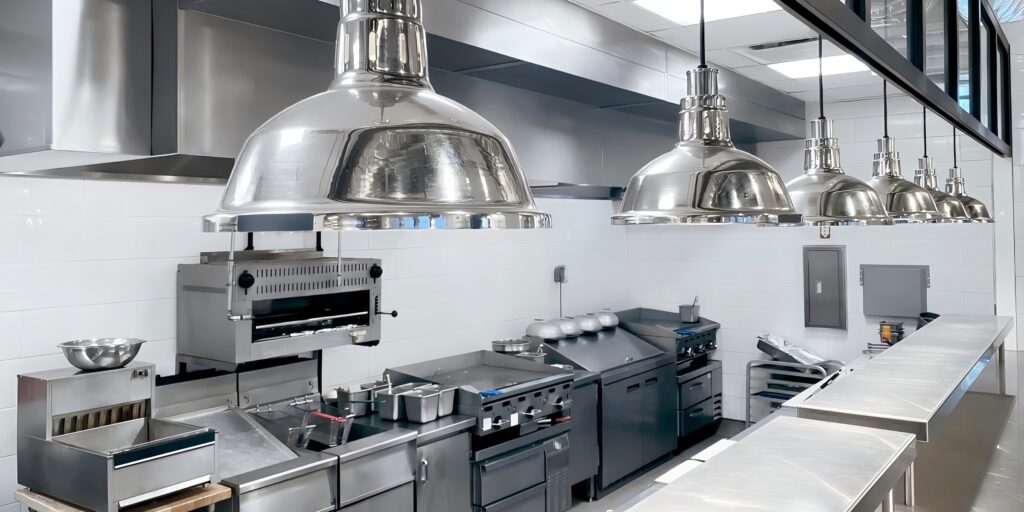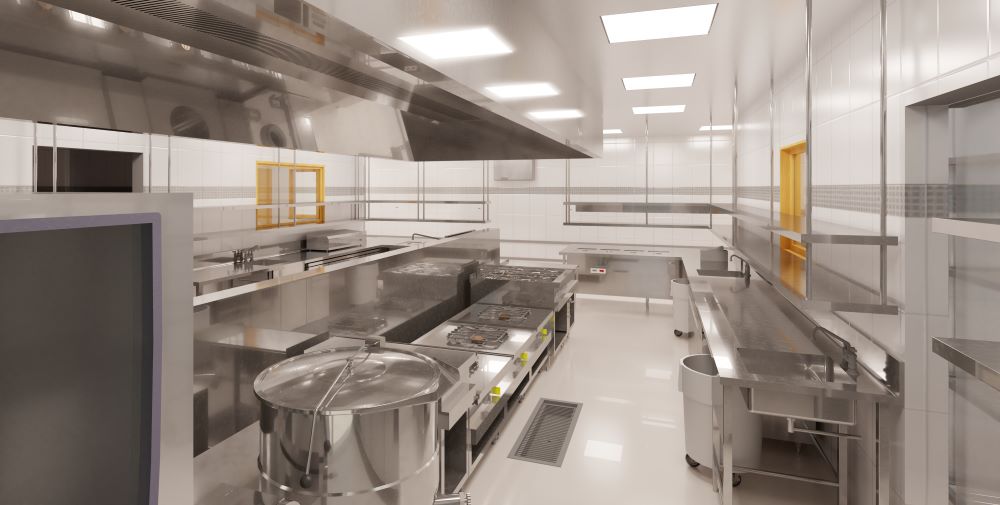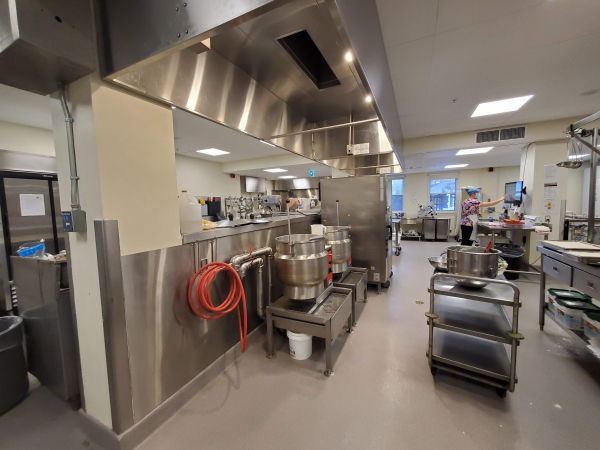Introduction
As a place that provides medical services to patients, hospitals not only need advanced medical equipment, but also efficient and safe kitchen equipment to ensure the catering needs of patients and medical staff. The function of hospital kitchens is not only to provide nutritious meals for patients, but also to consider hygiene, safety, efficiency and other aspects.
Why is hospital kitchen equipment important?
1. Ensure food safety
Hospital patients usually have low immunity and have extremely high requirements for food hygiene. If the food is unsafe or unhygienic, it may cause food poisoning, infection and other problems, further endangering the health of patients. Professional kitchen equipment can effectively prevent cross-contamination, bacterial growth and other problems, thereby ensuring the safety of food in processing, storage and distribution.
2. Meet special dietary needs
Different patients need special diets according to their conditions. For example, diabetic patients need a low-sugar diet, heart patients need low-salt food, and some seriously ill patients need liquid food. These have put forward higher requirements for kitchen equipment, requiring equipment to provide fine processing and accurate cooking control to meet special dietary needs.
3. Improve operational efficiency
Hospitals need to provide meals for a large number of patients, medical staff and employees every day. Efficient kitchen equipment can speed up food preparation, processing and cooking, ensuring that food is available on time, especially in a busy hospital environment, where time management is particularly important.
4. Maintaining a balanced diet
Patients’ nutritional intake is essential for recovery. Hospital kitchens need to use kitchen equipment to precisely control the cooking time and method of food according to the advice of nutritionists, avoid over-processing, and retain the nutrients in the ingredients, so as to provide patients with nutritious meals.
5. Reduce operating costs
Modern kitchen equipment usually has energy-saving functions, reducing energy consumption and reducing hospital operating costs. At the same time, durable and easy-to-maintain equipment can reduce the frequency of repairs and replacements, further reducing long-term operating costs.
6. Maintain hygiene and cleanliness
Hospital kitchens must maintain a high standard of cleanliness. Easy-to-clean equipment design and professional disinfection equipment can effectively prevent bacterial growth and ensure a hygienic kitchen environment. This is essential to prevent the spread of germs through food.
7. Provide support for medical staff
In addition to patients, the dietary needs of medical staff cannot be ignored. Good kitchen equipment ensures that they are provided with healthy and nutritious meals, thereby helping them maintain their physical and mental state to cope with high-intensity work.

Hospital kitchen layout
Cooking area: Set up equipment such as stoves and ovens for cooking various ingredients, and equip them with sufficient operating space.
Preparation area: Provide operating tables for cutting, washing and preparing ingredients to ensure the hygiene and safety of ingredients.
Distribution area: Install refrigeration equipment for storing ingredients and finished dishes, as well as conveyor belts or carts for convenient transportation of ingredients and dishes.
Cleaning area: Equipped with professional dishwashers and disinfection equipment for cleaning and disinfecting tableware, kitchen utensils and workbenches, etc.
Storage area: Provide sufficient storage space to store ingredients and kitchen supplies, and ensure the freshness and safety of ingredients.
Equipment area: Set up storage areas for maintenance tools and spare equipment to ensure the normal operation of kitchen equipment.
Common types of hospital kitchen equipment
1. Cooking equipment
Stove: used for conventional cooking operations such as frying and boiling soup, usually with electric stoves, gas stoves and other types.
Steamer: Suitable for steaming and cooking food, especially for patients in hospitals who need a light, low-fat diet.
Oven: Used for baking or grilling food, common ones are electric ovens and microwave ovens.
Wok: Commercial woks can handle a large amount of ingredients, suitable for large-scale production of hospital meals.
Boiler/stew pot: Used for cooking soup or stewing dishes in a large pot, especially suitable for situations where soup is needed in hospitals.
2. Storage equipment
Refrigerator: Used to store perishable foods and raw materials, such as vegetables, meat, seafood, etc.
Freezer: Used for long-term storage of frozen foods, meat, etc.
Insulated cabinet: Maintain the appropriate temperature of food, especially during meal preparation and food transportation, to prevent food from cooling down.
3. Food processing equipment
Vegetable cutter: Large-capacity automatic vegetable cutter can quickly and evenly process vegetables, reducing manual operations.
Meat grinder: Used to process meat into minced meat, suitable for making meat-filled foods.
Dough machine: Used to knead and make dough, which is convenient for preparing pasta.
Vegetable washing machine: Automated washing equipment can quickly and efficiently wash a large number of vegetables to ensure hygiene.
4. Cleaning and disinfection equipment
Commercial dishwasher: Efficiently wash a large number of tableware, knives and forks, etc., and can perform high-temperature disinfection, saving time for manual cleaning.
Disinfection cabinet: Ensure that tableware, kitchen utensils and utensils are sterile through high-temperature or ultraviolet disinfection.
Garbage disposal machine: Process kitchen waste, help keep the kitchen clean and reduce the amount of garbage.

5. Food transportation equipment
Dining cart: Used to deliver prepared meals to different wards or floors, usually with insulation function to ensure that the food is fresh and warm.
Insulated box: Keep food temperature during delivery to prevent meals from cooling during transportation.
6. Auxiliary equipment
Mixer: Used to mix and stir ingredients, especially suitable for making soups, sauces and other foods that need to be evenly mixed.
Juicer: Used to make fresh juice to meet the dietary needs of some patients.
Egg beater: Used to beat eggs, cream, etc., suitable for making pastries and other special meals.
7. Ventilation and exhaust equipment
Exhaust hood: installed above cooking equipment, absorbs oil smoke and exhaust gas, and ensures the air quality of the kitchen.
Ventilation system: Keep the kitchen ventilated, reduce the temperature and remove odors in the kitchen.
8. Tableware and storage containers
Stainless steel worktop: convenient for food preparation and cooking operations, easy to clean, and ensure hygiene.
Storage cabinet: used to store kitchen supplies, seasonings and dry goods.
Insulated soup bucket: used to keep soup warm to prevent the soup from getting cold or deteriorating during long-term storage.
9. Waste treatment equipment
Trash cans and garbage separation devices: perform garbage sorting to facilitate waste management and treatment.
Food waste crusher: used to handle food waste generated in the kitchen, reduce the amount of waste, and keep the kitchen clean.
Hospital kitchen hygiene and safety measures
1. Food safety management
Ingredients procurement: Hospital kitchens must purchase ingredients from qualified suppliers to ensure the freshness and safety of ingredients. In particular, for perishable ingredients such as meat, seafood, and vegetables, their source, production date, shelf life, etc. should be strictly inspected.
Food storage: Ingredients should be stored in different categories, and raw and cooked food should be separated. The temperature of refrigeration and freezing equipment should meet the standards, with the refrigeration temperature kept at 0-4°C and the freezing temperature below -18°C to prevent food spoilage.
Food processing area separation: Raw food processing areas and cooked food processing areas must be strictly separated to prevent cross contamination. Cutting boards, knives and other utensils used for raw and cooked food should also be used separately and clearly marked.
Food insulation and preservation: Cooked food should be kept at a temperature above 60°C to prevent bacterial growth. If cooked food is to be stored, it should be cooled quickly and stored in a refrigerated area to avoid bacterial growth at moderate temperatures.
2. Equipment cleaning and disinfection
Cleaning and disinfection frequency: All surfaces, tools, utensils and equipment in the kitchen should be cleaned and disinfected regularly. Tableware should be washed in a commercial dishwasher and disinfected at high temperatures to ensure sterility.
Garbage disposal: Kitchen garbage should be sorted and raw food residues, packaging materials, recyclables, etc. should be placed separately. Waste disposal areas should be kept away from food preparation areas to ensure hygiene and prevent odor and bacterial growth.
Ventilation and exhaust equipment cleaning: Clean exhaust hoods and ventilation equipment regularly to prevent grease accumulation and excessive fume concentration in the kitchen air, which affects food hygiene and air quality.

3. Staff hygiene
Personal hygiene standards: Kitchen staff must wear clean work clothes, hats and masks to prevent hair, sweat, etc. from falling into food. Hand hygiene is essential. Staff must wash and disinfect their hands after touching different ingredients, using the toilet or handling garbage.
Health monitoring: Regular health checks are conducted on kitchen staff to prevent people carrying infectious diseases from entering the kitchen to work. Any employee with a cold, gastrointestinal problems or skin infections should avoid contact with food.
4. Tableware and tool management
Zoned storage: Tableware and tools for different purposes (such as knives and cutting boards) should be clearly marked and stored in different areas. Cleaned tableware should be stored in a closed disinfection cabinet to avoid exposure to the air.
Tool disinfection: Knives, blenders, vegetable cutters, etc. should be cleaned and disinfected in time after use to ensure that there is no residual contamination when they are used again.
5. Kitchen equipment safety
Equipment operation specifications: All kitchen equipment such as stoves, ovens, steamers, etc., operators must be trained and familiar with the use of the equipment and safe operating procedures to avoid accidents caused by misoperation.
Equipment maintenance: Kitchen equipment should be inspected and maintained regularly to ensure its normal operation, especially high-temperature and high-pressure equipment such as steamers and boilers, which must prevent failures from causing fires or explosions.
6. Fire safety
Firefighting equipment: The kitchen should be equipped with sufficient fire-fighting equipment (such as fire extinguishers, fire blankets, etc.) and fire detectors, and their effectiveness should be checked regularly. Fume ducts and exhaust hoods should be cleaned regularly to prevent grease accumulation from causing fires.
Fire prevention measures: The cooking area should be kept away from flammable items, especially oils, cartons, etc. In addition, all gas equipment should have pipes and joints checked regularly to prevent gas leaks.
Emergency exit and evacuation passage: The kitchen should have clear emergency exit signs and keep the passages clear to ensure that staff can evacuate quickly in an emergency.
7. Anti-slip and protective measures
Anti-slip floor: The kitchen floor should use anti-slip and waterproof materials to reduce slippery floor and cause falls. If necessary, anti-slip mats can be laid next to the workbench.
Safety protection tools: Kitchen staff should wear protective gloves and aprons, especially when operating sharp tools or high-temperature equipment, to prevent burns and cuts.
8. Electrical safety
Electrical equipment maintenance: All electrical equipment such as refrigerators and blenders need to check the circuits regularly to prevent electrical fires caused by aging or short circuits. Sockets and power cords should be kept dry and avoid contact with water.
Power-off device: Large electrical appliances should be equipped with emergency power-off devices to facilitate quick power-off in the event of an electrical failure to avoid further damage.
9. Emergency incident handling
Emergency training: Kitchen staff should receive basic emergency rescue and fire-fighting training, understand how to deal with emergencies such as fires, burns, cuts, etc., and know the location of emergency exits.
First aid equipment: The kitchen should be equipped with a first aid kit containing common first aid items such as Band-Aids, disinfectant, bandages, etc. to deal with minor wounds or accidents.
Why Choose Us?

CNMEDITECH is dedicated to the long-term research of the medical consumables market. Our mission is “People oriented and win-win strategy,Matching the real needs of the region with a focus on human health,To be the world’s first-class medical field solution expert”. We have been manufacturing high-quality medical device products for more than ten years.
We have built our reputation on delivering quality healthcare solutions on time and on budget. All our products comply with international health and safety regulations and all products come with a warranty.
Are you still worrying about your customer’s product needs? Are you still angry that the product is expensive?Our medical consumables support personalized product customization.
Our company has many styles to choose from. In addition, we have high-quality pre-sales consulting guidance and professional after-sales service, all to meet your needs.
Whether it is a cost-effective or high-end product, there will always be something suitable for you. If you have any needs for products, you can ask us, our factory will meet your needs as soon as possible, and we will make every effort to provide you with solutions.Feel free to send us your inquiries.








